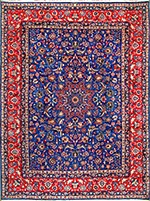Textiles Studies
Date of this Version
1990
Document Type
Article
Citation
THE TEXTILE MUSEUM JOURNAL 1990-1991, pp. 6-8.
Abstract
Twenty years ago when I set out on the course of a professional life in archaeology, I thought my future lay in ruins. Preparing this paper has given me an opportunity to review my experiences and reassess my perception of condition in general. And, specifically with respect to carpets, it has enabled me to develop a heightened sense of self-awareness and perception of "the hole." I have found upon introspective analysis two key aspects of my own training and experience that have profoundly affected my response as curator to the condition of carpets: The first is a background, prior to specializing in Islamic art, textiles, and Oriental carpets, in archaeology (initial graduate training and twelve years' field experience). The second was a Ph.D. minor in Conservation at the Institute of Fine Arts, which included courses and labwork on technology and analysis of structure in archaeological materials and works of art. Embarking on a career in archaeology that brought me biennially to the Middle East, I set about in earnest thinking of losses and what to make of them: identifying lacunae, circumscribing evidence, and recording ephemeral data that describe the nature of archaeological excavation and serve as the basis for all subsequent interpretation. One learns to piece together fragmentary bitsofinformation gleaned painstakingly from all manner of sources (written, visual, oral) in order to gain meaningful understanding of mankind's past, present, and future. Interestingly, the two fields of archaeology and conservation are allied in many ways; they are also in some ways antithetical to one another.
Included in
Art and Materials Conservation Commons, Art Practice Commons, Fiber, Textile, and Weaving Arts Commons, Indigenous Studies Commons, Museum Studies Commons


Comments
Copyright © 1990 The Textile Museum.